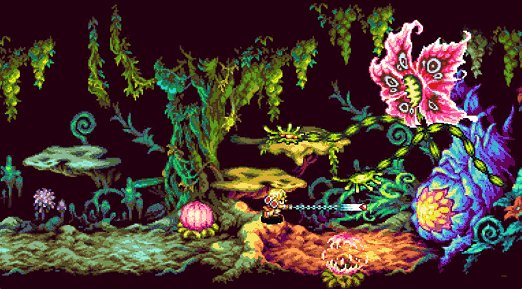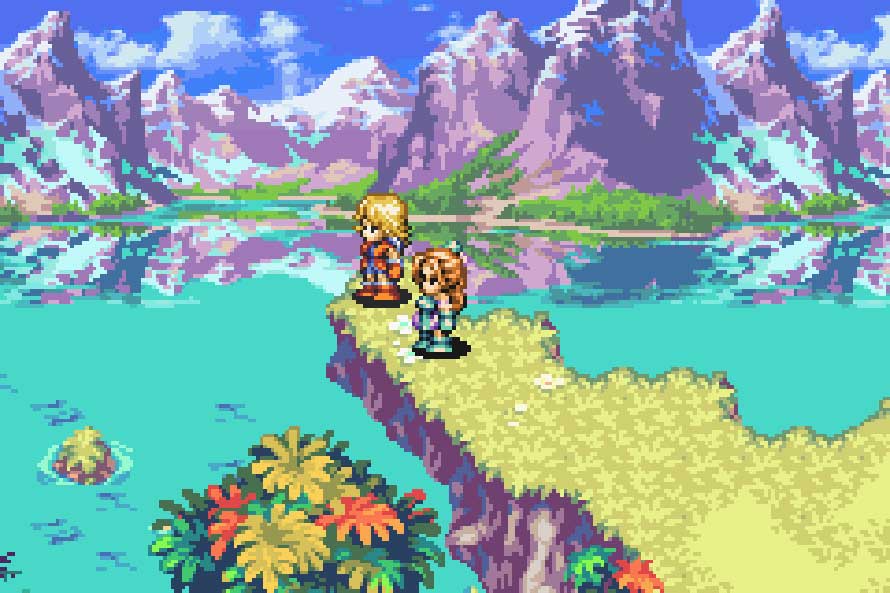|
|

|
BATTLE SYSTEM
|

|
INTERACTION
|

|
ORIGINALITY
|

|
STORY
|

|
MUSIC & SOUND
|

|
VISUALS
|

|
CHALLENGE
|
EASY
|
COMPLETION TIME
|
12-20 hours
|
|
OVERALL
3/5
|
Rating definitions
|
|
|
It seems that few developers, even those who should really be concerned with making a name for themselves, are interested in breaking new ground these days, especially when it comes to the handheld market. The GBA has seen a steady succession of sequels that bear a little too much similarity to their ancestral brethren, along with any number of remakes from the SNES days and beyond. One such effort is Sword of Mana. Made by Brownie Brown, which is staffed by several developers who were employed by Square back in the day when the original game, Seiken Densetsu(or Final Fantasy Adventure for all us North Americans who are apparently too ignorant to appreciate anything that doesn't contain those two magic words) was first released for the Game Boy, Sword of Mana is much like a new paint job patchy enough to expose how very little the Seiken Densetsu series has changed over the course of fifteen years. The gameplay, while entertaining, has issues, and ultimately, shiny new looks, characters, and sounds can't disguise the fact that this remake is something of a Frankenstein.
The game kicks off by offering players a choice between a male or a female hero. This is already a departure from the original, but a decidedly mundane one; aside from fleshing out the story slightly in either direction, the only difference between the two is what kind of armour they can wear and which weapon, the sword or the staff, players do not get to level up. The rest is classic; bash stuff repeatedly with your weapons, and they shall improve. Flambée nasty critters until they're crispy with some help from Salamando, and presto - fire magic becomes that much toastier! It works well in theory, but in Sword of Mana it tends towards needless repetition, especially since with only four weapon classes, half the weapons are pretty much excess baggage, and spiky excess baggage at that. The elementals, meanwhile, are even worse; while enhancement spells have a certain degree of variety, the attack magic, besides being identical across the board, rotates between various spell graphics on a seemingly arbitrary basis. Compounding the sameness, each elemental's spells will be the same regardless what level they are(the only real modifier that seemed to have an impact on the changes was the cumulative level of all elementals combined.) Of the different spell animations, several are difficult to aim, and it doesn't make sense that harder-to-aim types would recur after building a spell to a certain level, but they do.
Players can also charge their weapons gradually for a more powerful attack, a procedure that mirrors the one found in Legend of Mana and Seiken Densetsu 3. While it lacks the time-consuming waddling of Secret of Mana, this approach does tend to be a little less impressive in the end, although it does tend to come in handy when that rabite just won't explode into a little shower of goo. Ultimately, Brownie Brown stuck to a safe approach, and the results, while bland, are serviceable; perhaps the word that would best sum up the changes is "redundant."
 When pesticide just doesn't cut it
When pesticide just doesn't cut it
|
|
On the other hand, for a GBA title, the sound wasn't too bad. For one thing, the music in FFA was good to begin with, so gussying it up for a system that rarely makes use of the full extent of its sound capacity was apparently less than difficult, in view of the fact that a few of these rearrangements just involve synthing one of the voices in a track and then letting the original square wave do the rest. About the only problem with the music is the fact that one of the dungeon themes was dreadfully repetitive. The sound effects, meanwhile, are serviceable, though the GBA has never been much for amping up its aurals.
So while it would have been silly to expect very much improvement out of the sound, it's a little more troublesome to see that little effort was made to push the visual capacity of the GBA to its limit. The artistic design of the game bears the characteristic stamp of the SD series, with things leaning pastel without being sickly. The character design is also this side of frilly, though at least it is possible, most of the time, to determine the gender of various characters. Even so, there wasn't much in the way of special effects, and for lack of a better term, things could have been a little crisper.
Another issue Sword of Mana suffers from is its translation, and by extension its storyline. Besides containing a few spelling errors, it is also rather painfully obvious that the script was either censored or not very good to begin with. There seems no logical reason why anyone would think that a natural thing for a character to scream would be "BLAST IT! BLAAAAAAAAAAST IT!!!!!", and beyond that, the plot is maddening in its unwillingness to cast anyone as a bad guy. Every character who starts out in opposition to the player will eventually end up being canonized in an Aryaesque hit list of tearful prayer that the male hero lovingly recites each time the opportunity for mawkish revenge fantasy crops up. Worse still, there seems to be no plausible explanation as to how the main bad guy ends up going from his role in the backstory to the part he inevitably ends up playing over the course of the game's events. Add to that a random cameo by a soul-sucking demon and a few other characters with limited background and questionable purpose and it becomes apparent that somebody should have given the story a slightly more thorough once-over.
 Nature sure is boring!
Nature sure is boring!
|
|
Speaking of once-overs, it'd be nice if the ring menu was as simple to navigate as it was in Secret of Mana, because Sword of Mana seems to delight in burying gamers in a labyrinthine maze of button pushes over the simple task of retrieving an item. Mercifully, this is the only area of the menu where this problem occurs, but would it really have been so difficult to remove the heading "other items" and then plunked its contents in the main menu? Apparently so. It's strange, because the rest of the menu is quite streamlined, and easy to navigate. The level-up dialogue only appears when players need to use it, and the NPC gets taken care of automatically by the CPU. Players, meanwhile, are left to chart a course for their characters through a list of six job types. Depending upon the combination of classes they choose, gamers will end up with a specialized killing machine, as accumulating enough points in a certain levels grants additional stat bonuses to their character, above and beyond the regular enhancements achieved with each level.
This makes Sword of Mana an appealing choice to play over, since it is possible to end up with a dozen or so different outcomes. Depending on the class specialization, it also goes a long way to determining how a character attacks, so it is definitely worthwhile to play through more than once, especially considering there are two different characters that can be used. That said, the gameplay isn't really all that compelling, and Brownie Brown's additions consist mostly of content ganked from Legend of Mana. Watts the hostage Blacksmith and the seed-growing tree make cameo appearances, Watts to provide armour and the tree to provide the seeds that enable players to buff it (along with weapons), and the utterly pointless cactus diaries also show up. A number of generally tedious sidequests have also been added to the game's various towns, but they are largely busywork and don't really serve to enhance the gameplay any. Indeed, it would be quite refreshing to see a developer attempt to enhance a game's playability for once, rather than just tacking on menial fetch quests as a copout solution to a poorly fleshed-out title. Sadly, Brownie Brown does not appear to be that developer, and since even its enhancements amount to self-plagiarism, Sword of Mana ends up falling short of what it could have been.
Sword of Mana, in the end, boils down to a fairly tried-and-true system of gameplay, and while the additions Brownie Brown add a little shine, ultimately it relies on that fun factor to keep gamers playing to the end. The game is, however, enjoyable enough that even its many failings do not drag it down completely, and while it certainly could have been better, so too could it have been much, much worse. While 15 hours or so of gameplay won't exactly keep gamers occupied for months on end, the replay value, choice music and decent variety in the leveling system will keep them coming back for more, and thus, while the shortcomings are many, the game still manages to leave a reasonable impression. Just don't expect greatness.
Review Archives
|









